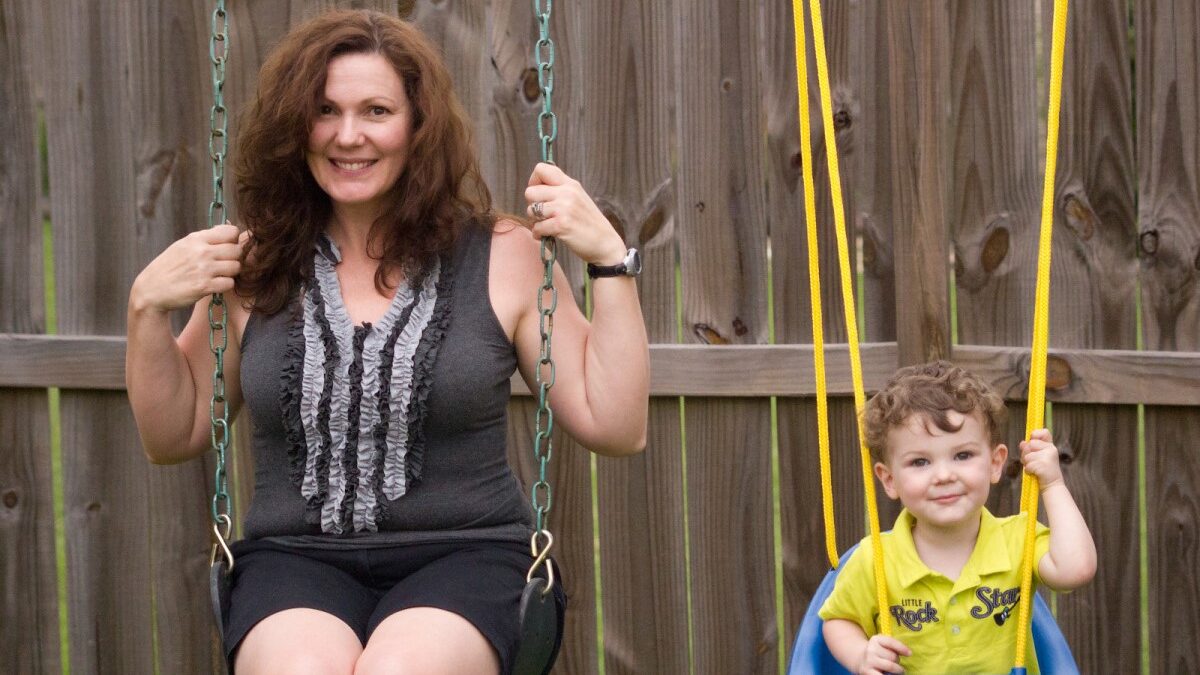
Every morning I sat on my bed with my knees tucked up to my chin and prayed: “Please let the baby be okay. Please let the baby be okay.” I didn’t really believe in God. But, like many non-believers, I turned to him when I needed something done that was out of my control.
Although the ultrasounds had all shown a heartbeat and the doctors said everything looked good, I had been bleeding for most of the eight and a half weeks of my pregnancy, and I knew something was wrong.
So I prayed and I prayed and I prayed. In the end, God didn’t answer my prayer. That’s how I knew he is real.
From Baby to Tissue
My husband and I stared desperately at the grainy black and white monitor in the doctor’s office, waiting for that little flicker that meant our baby’s heart was beating. It was a sight we’d seen only a week before as the doctor pointed out little budding arms and legs. Now there was nothing; the sound of the doppler a cold, dead hiss.
“I’m sorry,” the doctor finally said. “There’s no heartbeat.”
There it was, literally in black and white. God had not answered my prayer. In shock, I asked the doctor what would happen now. In a voice that was brisk and businesslike this woman who, the week before, had been talking about “my little peanut” and saying, “Look, he’s waving to you!” began to outline what we had to do to “remove the tissue.”
I had two choices: I could undergo surgery to “remove the products of conception,” or I could take a pill that would allow “it” to “pass on its own.” I was already in shock. My inner voice had gone radio silent. All I could think was that surgery seemed drastic, frightening. My husband agreed. We chose the medicine.
When the baby had been alive, the doctor talked to me frankly about sperm and eggs, yolk sacs and embryos. But now she was vague, avoiding my questions or answering them incompletely. From somewhere behind the heavy curtain that had fallen over my mind, I asked, “Will it hurt?”
“It’ll be manageable,” the doctor replied, handing me a prescription for a powerful painkiller.
“Will I have to see it come out?” I asked, not even really sure what “it” meant.
“You don’t have to look.” We went home with our prescription.
The Crippling Guilt of Miscarriage
The moment you find out you’re pregnant, you become a mother. Your hopes and dreams grow wings and expand ever outwards, building a life for the child that has begun to grow inside you. Somehow the grainy grey blob on the ultrasound image looks to you like the baby it will one day become. Although what we were looking at was an embryo no larger than a kidney bean, to me it was my baby. And now my baby was dead.
The guilt was crippling. There was no doubt in my mind that this was somehow my fault. I had failed at the first job of motherhood. My body wasn’t a good home for this baby. The doctor, with all her talk of “the tissue” and “passing on its own,” had not told us anything about why this might have happened. It was my job to nurture and care for our growing child. I had failed.
Was my baby angry? I wondered incessantly. Did it wish it could have lived? Did it wish it could have had a different mother? One whose body could have sheltered it better?
“I’m sorry!” I moaned over and over, my words unintelligible through my tears. “I’m sorry, I’m so sorry!”
I Can’t Take the Pill
In the morning, I couldn’t take the pill. I stared at the prescription bottle and, like a child, clamped my mouth shut tight. Something was telling me no. This is not what you are meant to do. No.
I got out my computer and googled the drug they had given me. I found post after post submitted by other women who had taken it, and I sat at my computer and read until I couldn’t stand it any more.
Finally I stopped reading, horrified at what I had nearly done. A miscarriage isn’t the way they portray it on TV, or in books: a scream, a gush of blood, some quiet tears. It’s a nightmare of horror-movie proportions.
If left to her own devices, a woman going through a miscarriage could be “miscarrying” for weeks on end. She would suffer contractions as her cervix opened, getting ready to expel the embryo, placenta, and uterine wall, and she would bleed copious amounts of blood. There would be clots and liver-like pieces of placenta. Eventually, she would expel the gestational sac, a small, white bubble with her baby visible inside. My doctor had told me none of this.
Already this process had begun to happen to me. Thick rivulets of blood were sliding out of me and into the toilet bowl each time I went to the bathroom, making strange inkblot shapes as they pooled in the water.
“Will I have to look?” I had asked the doctor. How could I not look? There were women, I read, who reached into the toilet and pulled out the gestational sac, holding it in their hands and staring through it to get a glimpse of the baby they might have had. But in the end, there was nothing else to do but flush their babies down the toilet. How could anyone, anyone, ask that of me?
With the drug they had given me, this process that could take weeks would instead be condensed to a matter of hours. All the pain, the blood, the “tissue” (as the doctors refer to everything that is expelled, including the embryo), would be on the fast track.
“Will it hurt?” Of course it will.
Is My Only Option an Abortion Clinic?
I knew now that I couldn’t take the medicine. I wanted the operation, the D and C, and I wanted it now.
D and C stands for Dilation and Curettage. The patient is placed under general anesthesia and the doctors dilate her cervix and suction out the gestational sac (with the embryo inside) and the placenta. Then they use a tool to gently scrape away the rest of the uterine lining to make sure nothing is left behind that would complicate things should the woman decide to get pregnant again.
I called the doctor’s office to tell them I’d changed my mind. That was fine, they told me, offering me a list of clinics that could perform the procedure.
“But please know,” the nurse told me, “these are clinics for women who are terminating their pregnancies.”
Abortion clinics. I would be sitting in the waiting room with women who had living babies inside them who had come for the sole purpose of ending those lives.
“Is there nowhere else I can go?” I asked, my tears, ever present, bubbling to the surface.
“The doctor who performs D and Cs in our practice says you are too far along for her to do it,” the nurse replied. I thanked her and hung up. I didn’t know what else to do. I made an appointment at an abortion clinic.
‘A Woman Wants to Know’
At this point my mother arrived. She came in a whirlwind of hearty soup, warm hugs, and herbal tea. It was a miracle. Together we researched the clinic my doctor had recommended, and were horrified. There were accounts of exam rooms with blood on the floor, multiple women to a room, people screaming. Within what felt like moments, my mother helped me get an appointment with a preeminent obstetrician specializing in pregnancy loss.
The next day, my husband and I sat in this doctor’s office. He was a grandfatherly man with a Santa Claus twinkle in his eye and an air of experience that was almost palpable. He reached behind him and placed a box of tissues gently down on the desk in front of me.
“Most doctors will tell you,” he began, looking at me frankly, “that with a first miscarriage, testing isn’t necessary.”
He was referring to the testing that can be done on a miscarried embryo to determine the cause of the miscarriage. If it is determined to have been caused by a chromosomal abnormality, as most miscarriages are, the chances of it happening again are slight. It was a fluke.
But the tests could also reveal a hormonal problem or a genetic problem, meaning that, without intervention of some kind, the woman would continue to miscarry. Just as my new doctor said, I had been told these tests weren’t necessary.
The doctor leaned back in his chair, his eyes never leaving mine. “But they don’t understand,” he said, dismissing those other doctors with a wave of his hand. “A woman wants to know.”
My mind, which had been dulled with shock and grief, suddenly lit up. Yes! Yes! my inner voice was screaming. A woman wants to know. I want to know. We scheduled the D and C for the following afternoon.
Knowing Brings Peace
The next day found me at the hospital, lying on a table in a crackly paper gown. My new doctor’s twinkling eyes above his face-mask appeared above me. His hand slipped into mine. I gripped his fingers. As the plastic mask was lowered over my face, administering the anesthesia, it was suddenly my own, long-dead grandfather’s eyes looking down at me over the doctor’s face mask.
Four weeks later, my husband and I went back to the doctor.
“It was a chromosomal abnormality,” the doctor told us, without preamble. He then proceeded to explain to us, without euphemism and with clarity, what this meant.
In our case, the most likely explanation for the abnormality was that the egg had been fertilized by two sperm. So, even though it had enough information to begin growing, it never could have continued to grow into a baby. I felt a weight lift from my shoulders. It wasn’t my fault. We could try again. It was a fluke. Random. Unlikely to happen again.
Now I knew. My chances of having another miscarriage were no greater than someone in her first pregnancy. If I hadn’t had the testing, I never would have known that. I would have had to try again, not knowing if every pregnancy I ever had was doomed to end in miscarriage. But now, at least, I could hope again.
The Prayer I Didn’t Know I Was Praying
All that time I had been praying the wrong prayer. The embryo that had begun to grow inside of me never could have grown into a baby. It had a beating heart, it was alive in some way, but it was never going to be my child. Allowing it to continue to grow would have been disastrous.
God knew that. He had the whole picture, while I only had a tiny part. So he didn’t answer my prayer. Instead, he led me to the path that would give me the strength to try again. And he gave me himself, so I could lean on him when my strength wavered. He answered the prayer I didn’t know I was praying.
A few weeks later, I found myself standing in a church, blinking in the half light. I walked to the shelf of flickering candles, and knelt on the red velvet cushion. Carefully, I selected a candle and lit it, dropping it into the metal holder. I closed my eyes.
I conjured an image of my baby, the picture they’d given us of a grainy grey form, a little flickering heart. I let all the hopes and dreams I’d had for my baby fill my mind. The life I’d imagined for him or her that had sprung, almost unbidden, into being that first moment I learned I was pregnant.
Tears seeped from behind my closed eyelids, but I did nothing to wipe them away. For a long moment, I knelt with the candlelight flickering over my face and held my baby in my heart. Then, with a long shuddering breath, I opened my eyes. My candle burned brightly in its place next to all the others. I kissed my fingers and pressed them to the metal candle holder.
“Goodbye,” I whispered. “Goodbye. Goodbye. Goodbye.”









